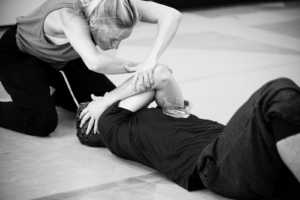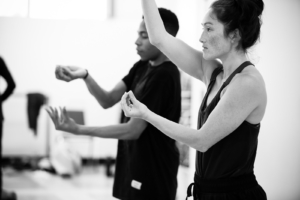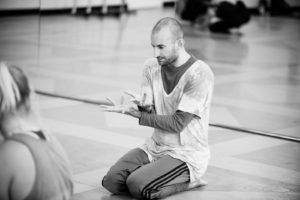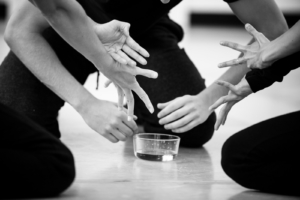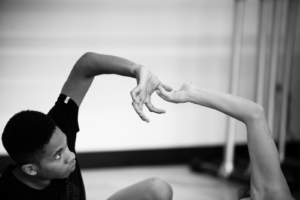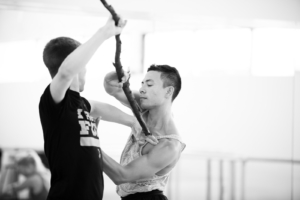“I’ve never done anything like it,” exclaims dancer Tory Peil of Adam Barruch’s Summoning, which debuts tonight as part of Whim W’Him‘s CHOREOGRAPHIC SHINDIG III on Capitol Hill. “Having been raised by hippies,” as she adds, Tory half-expected some apparition to rise out of the studio floor, invoked by the uncanny energy in the room.
The influences on Adam that called up Summoning run the gamut. He has long been interested in ritual and magic, the inner logic of nature, taboos. As a child he says he didn’t particularly connect to the Judaism of his parents, but when he heard tell of the Kabbalah in the 1990s, his interest was piqued. He asked his Hebrew school teacher about it. She gave him a book on Jewish mysticism, which at that point he equated with magic—Jewish magic. Later, he understood Kabbalah to be concerned with “the inherent structure of what exists,” and now adds: “Magic is the most intimate way to relate to it, to be able to internalize and harness that kind of power.” He was also taken with The Magicians books by Lev Grossman and the TV series based on them. “I like that sort of thing,” Adam says softly, and perhaps a little slyly.
Such an enterprise might easily slip into cheap ‘woowoo’ mystification, but Adam’s choreography and the dancers’ compelling performances seem instead to tap into something primitive, something deep and old and strange. We, as outsiders stealing a look at their curious doings, are drawn into believing them to be adepts of ancient, unfathomable Mysteries. This is not what children call “magic”—card tricks or clever illusions. It has the feel of the real stuff.
With Summoning, Adam has been mesmerized by hands as a source of power—arms and hands. In the last year or so, he’s been considering both the casting of spells and intentionality. Once in the studio, he charged each of the dancers with creating a love spell, a protection spell, a death spell. They did partner spells as well, with large stirring and bell-ringing motions. Generating hand gestures, complex and intricate, on their own and in pairs, building on ideas proposed by Adam or themselves, together they formed a common vocabulary in which hands and arms are the center of focus and strength.
In the finished piece, the dancers are like acolytes of some obscure practice whose exact meanings have been lost in the dim reaches of time. They invoke spirits, cast spells and practice elaborate convokings. Things from nature—sticks, rocks, water—help to imbue the ritual, and the spirits and bodies who carry it out, with purpose. All the personages in Summoning appear to have learned exactly what they are supposed to do. They execute their tasks with quick, precise and sure articulation.
Because it is so detailed and clearly intended, Adam imagines that some watchers will try to decipher the language, to decode the particularities of individual gestures. He adds bluntly, “I think people will misunderstand this.” For although there is an underlying abstract narrative in Summoning, “it is not a literal word-for-word language.” The dance here is a vehicle or conduit for eliciting an experience of spirit and body, to be felt by the audience as well as the performers. In this process, Adam declares, “There is inherent drama. That’s why I am called to move.”
